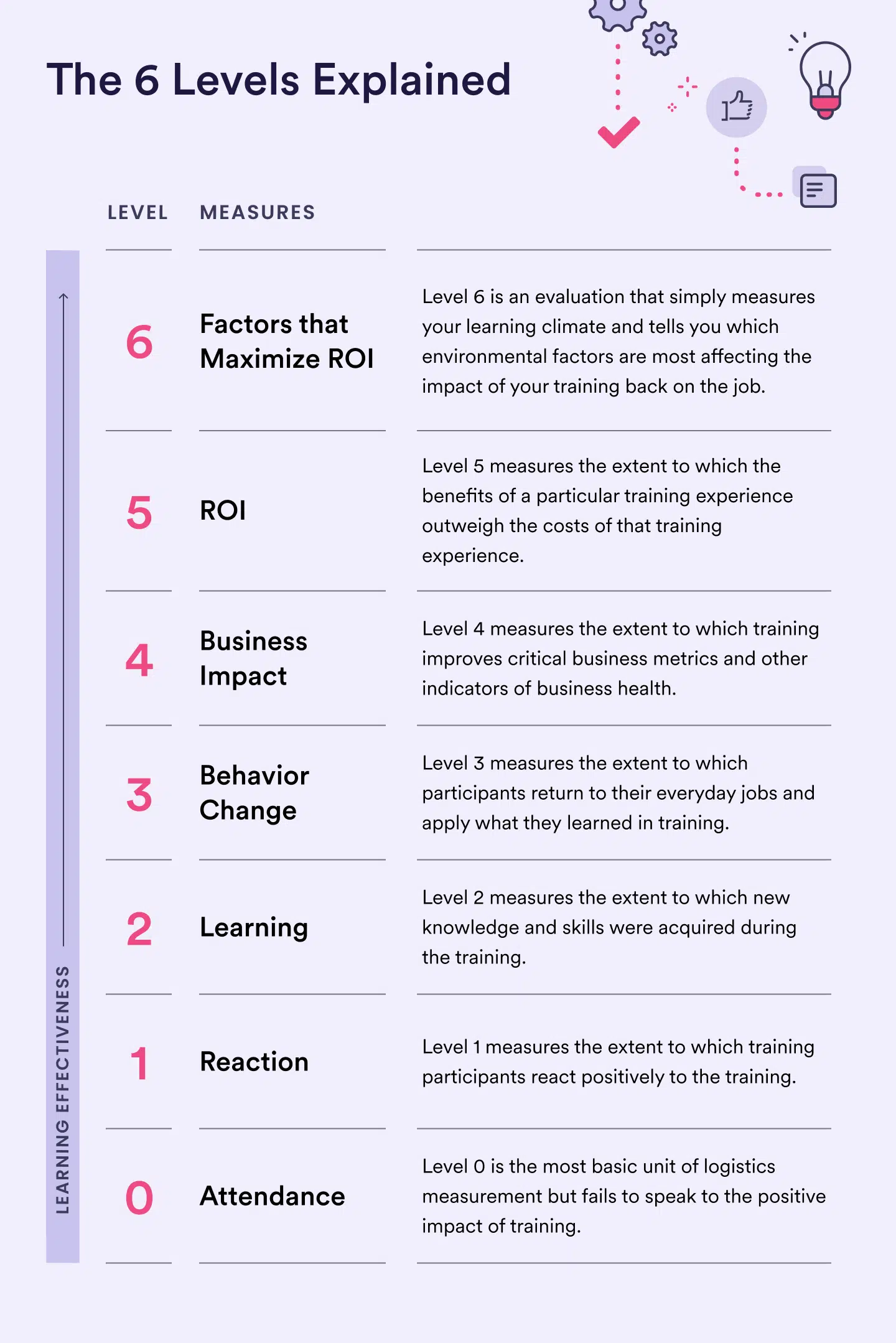What is Training Effectiveness?
The definition of training effectiveness refers to the measurement of the impact on learners’ knowledge, skills, and performance. It also refers to the company’s return on investment. Generally, training effectiveness is how well training supports learning and the transfer of training. Organizations must clearly define the training’s goals and objectives to accurately measure and evaluate training effectiveness. The Centers for Disease Control and Prevention (CDC) defines the purpose of training as helping improve the learner’s competence, capacity, and performance. But businesses may have more specific metrics.
Why is it Important to Measure Training Effectiveness?
Learning and Development (L&D) teams often must prove training programs’ return on investment (ROI). Organizational leaders want to know if invested resources like time, money, and energy are worth the expense.
Plus, training evaluations help organizations identify if training achieved their intended outcomes. Organizational administration can use them to make decisions about future programs.
L&D leaders who have the data ready when asked can prove the program’s worth. Not only can having ways to measure the ROI of training and development help them avoid budgetary cuts, but it can also improve their request for an increase in funding.
Training evaluations also allow management to communicate the company’s vision with employees. These conversations empower workers to align with the business’s goals. In addition, managers can review direct reports’ professional ambitions and the skills they need to get there.
Additionally, individuals may believe that workplace learning is purposeless without metrics. Organizational stakeholders want to see the monetary ROI, and participants want to see positive results from spending time and energy training.
Studies have shown that businesses that regularly invest in the proper training type perform better than those that don’t. But training must be meticulously tracked and measured.
10 Reasons to Measure the Effectiveness of Training and Development
- To determine if the training benefits employees’ skills and performance
- To find out what participants achieved
- To discover the path employees need to take to reach their next professional milestone
- To uncover issues in the training process and improve it
- To convert the training impact into additional revenue
Furthermore, effective training leads to the following:
- Higher employee performance and satisfaction
- Boosts in team morale, engagement, and company culture
- Positive encouragement about what participants did well
- Beneficial feedback about where employees can improve
- Improved HR metrics like better retention and recruiting
What is Training Effectiveness vs. Efficiency?
Training efficiency relates to the utilized time and resources. Time is measured in minutes, hours, days, and so forth. But resources can include spent money, energy, and more. Therefore, efficiency maximizes time and resources.
Monitoring training efficiency may seem like more work, but stakeholders will likely find the benefits of doing so worthwhile. Some of the benefits of this metric include the following:
- Avoiding wasting money and resources on something that does not benefit the company.
- Proving the ROI for training by demonstrating that funds are well spent.
- Creating a more skilled and efficient workforce.
How to Measure the Effectiveness of Training:
1. Identify Training Key Performance Indicators Before Starting Each Learning Program
Although an evaluation occurs after training, L&D teams should plan for assessments during the training design phase. In addition, L&D must work with stakeholders and training developers to identify the purpose and data collection methods.
Top Stakeholders in a Training Evaluation:
- Organizational Leadership Team
- Instructors, Coaches, and Facilitators
- Managers and Departmental Leaders
- Direct Reports, Employees, and Trainees
Intentions are unique to the business and its long-term goals. When organizations know the desired outcome, they can see if they are on the right track and make necessary adjustments as needed.
Key performance indicators (KPIs) are time-based and specific. They represent actions and moments that align with achieving business goals. By setting KPIs for learning and transfer of training, L&D teams can identify trends and recognize areas of strengths and improvement.
Evaluating learning involves assessing the participant’s success meeting the training’s objectives. Evaluating the transfer of training consists in determining how successful learners apply their knowledge to the workforce.
2. Use Analytics and Check-ins During Training Program Evaluation
Training effectiveness management uses scientifically validated evaluation techniques. In addition, data analytics can help track progress over time and show comparisons to similar companies.
The more data and analytics L&D teams can show in the training evaluation strategy. It is easier for decision-makers to understand if investments and efforts are paying off. In addition, training analytics interpretations impact understanding of company culture and growth opportunities.
L&D teams can utilize technology to showcase and track the progress of training program evaluation methods. They can create a model for specific inputs and outputs based on the company’s goals, allowing easy management and improvement actions to sustain an effective training strategy. Once enough data is gathered, it can show progress and see areas to focus on.
3. Create Feedback Loops in Training Programs
Qualitative data is only a part of training evaluations. Commentary and healthy debate from stakeholders help organizations accomplish training objectives. It’s essential to ask how each participant consumes information because learning styles vary.
Feedback loops help ensure that communication standards are transparent and available at all levels. Additionally, input opportunities promote fairness and lead to more buy-in from teams.
For example, L&D teams can ask each participant if training is too challenging, uncomfortable, or a new experience. Then they can problem-solve to alter or refine training styles or systems of continued learning.
4. Evaluate Training Program Performance
L&D teams and organizational leaders can better understand the impact of training by looking at the factors commonly used and incorporated into an evaluation strategy, which include:
- Attendance
- Reaction
- Learning
- Behavior Change
- Business Impact
- ROI
- Factors that Maximize ROI
These levels help explain engagement factors that can be analyzed to show success or ways to improve programs. L&D teams can easily apply a formula and identify where to continue to focus time, investment, and energy.
5. Present Training Evaluation Strategy Findings to Leadership
Stakeholders need to know if learning programs and L&D teams use funds wisely. Showing data and performance outcomes with leadership is more successful when everyone is on the same page before starting each training session.
Presenters should keep the business impact and agreed-upon training outcome at the forefront of the conversation. By doing this, stakeholders know the L&D team put thought and care into ensuring the training program was set up for success and to achieve the organization’s end goals. Further, they can build confidence and synergy by finding solutions that fit the evaluation strategy and support the team.
What Factors Impact Training Effectiveness?
Many elements can threaten the effectiveness of training. Even the best learning and development program can fail to meet goals if individual differences stand in the way, such as:
- Preferred learning styles
- Cognitive ability
- Motivation
- How information is retained
- Learning speed
- Workplace learning culture
L&D leaders must understand how these dynamics impact a broad spectrum of unique personalities. For instance, age groups and experience levels can play a role in effective learning styles. A recent LinkedIn study revealed that over 70% of talent developers plan to change their L&D program to accommodate Gen Z employees.
The ROI calculation can fall flat if participants are not connecting with the information. Therefore, it is best to get buy-in from each prospective learner and key stakeholders to measure impact and a comprehensive view of worthy training and development investment.
Training Effectiveness for Learning Leaders Takeaways
Developing and implementing a training evaluation strategy gives L&D leaders an advantage when proving the value and effectiveness of learning programs. In addition, training metrics and analytics are powerful tools when making a manager training budget and justifying funding from leadership.
- L&D team leaders often need to explain and illustrate training and development ROI.
- It is easier to measure training ROI after identifying KPIs in the development phase.
- Additionally, obtain feedback from and consult with participants and stakeholders throughout the process.
- Don’t forget to build data collection and an evaluation strategy early in development.
- Analytics and data can prove training effectiveness and ROI and help secure funding.
L&D teams and organizational leaders need to identify what they hope to accomplish and what resources they have for training programs. Establishing goals and KPIs with stakeholders help assess learning opportunities’ success and areas for improvement within the training effectiveness.















